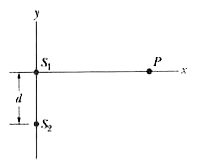Among two interfering sources, let S1 be ahead of the phase by 90∘ relative to S2 . If an observation point P is such that PS1−PS2=1.5λ , the phase difference between the waves from S1andS2 reaching P is
3π
5π2
7π2
4π
The correct Answer is:B
Δϕ1=π2
Δϕ2=(2πλ)(Δx)
=(2πλ)(1.5λ)
=3π
∴Δϕnet=Δϕ2−Δϕ1=5π2 .
Topper's Solved these Questions
- SUPERPOSITION OF WAVESBOOK - DC PANDEYCHAPTER - SUPERPOSITION OF WAVESEXERCISE - Level 2 More Than One Correct
6 Videos
- SUPERPOSITION OF WAVESBOOK - DC PANDEYCHAPTER - SUPERPOSITION OF WAVESEXERCISE - More than One correct Options
1 Videos
- SUPERPOSITION OF WAVESBOOK - DC PANDEYCHAPTER - SUPERPOSITION OF WAVESEXERCISE - Subjective Questions
6 Videos
- SOUND WAVESBOOK - DC PANDEYCHAPTER - SOUND WAVESEXERCISE - Exercise 19.7
4 Videos
- THERMOMETRY THERMAL EXPANSION AND KINETIC THEORY OF GASESBOOK - DC PANDEYCHAPTER - THERMOMETRY THERMAL EXPANSION AND KINETIC THEORY OF GASESEXERCISE - Medical entrance gallary
30 Videos
Similar Questions
Among two interfering sources, let A be ahead in phase by 54∘ relative to B. If the observations be taken from point P, such that PB−PA=1.5λ, deduce the phase difference between the waves from A and B reaching P.
View SolutionFigure shows two point sources S1 and S2 that emit sound of wavelength λ = 3.00 m. The emissions are isotropic and in phase, and the separation between the sources is d = 16.0 m. At any point P on the x axis, the wave from S1 and the wave from S2 interfere. When P is very far away (x≈0) , what are (a) the phase difference between the arriving waves from S1 and S2 and (b) the type of interference they produce? Now move point P along the x axis toward S1. (c ) Does the phase difference between the waves increase or decrease? At what distance x do the waves have a phase difference of (d) 0.50λ,(e)1.00λ, and (f) 1.50λ?

View Solution
Knowledge Check
Among the two interfering monochromatic sources A and B, A is ahead of B in phase by 66∘. If the observation be taken from point P, such that PB−PA=λ/4. Then the phase difference between the waves from A and B reaching P is
A(a) 156∘B(b) 140∘C(c) 136∘D(d) 126∘A coherent light is incident on two paralle slits S1andS2. At a point P1 the frings will be dark if the phase difference between the rays coming from S1andS2 is
Anπ radiansB(n+0.5)π radiansC(2n+0.5)π radiansD(2n+1)π radiansTwo waves of equal amplitude a from two coherent sources (S1&S2) interfere at a point R such that S2R−S1R=1.5λThe intensity at point R Would be
AZeroB2a2C5a2D6a2
In Fig. , two point sources S1 and S2 which are in phase and separated by distance D=1.5λ , emit identical sound waves of wavelength λ.
(a) What is the path length difference of the waves from S1 and S2 at point P1, which lies on the perpendicular bisector of distance D, at a distance greater than D from the sources ? (That is, what is the difference in the distance from source S1 to point P1 and the distance from source S2 to P1?) What type of interference occurs at P1 ?
(b) What are the path length difference and type of interference at point P2 in fig.
(c ) Figure shows a circle with a radius much greater than D, centered on the midpoint between sources S1 and S2. What is the number of points N around this circle at which the interference is fully constructive? (That is, at how many points do the waves arrive exactly in phase?)
View SolutionThree coherent sourcesS1,S2 andS3 can throw light on a screen. With S1 switched on intensity at a point P on the screen was observed to be I. With onlyS2 on, intensity at P was 2I and when all three are switched on the intensity at P becomes zero. Intensity at P is I when S1 andS2 are kept on. Find the phase difference between the waves reaching at P from sources S1andS3.
View SolutionIn double slit experiment SS2 is greater than SS1 by 0.25λ. Calculatethe path difference between two interfering beam from S1andS2 forminima and maxima on the point P as shown in figure.

View SolutionSounds from two identical sources S1 and S2 reach a point P. When the sounds reach directly, and in the same phase, the intensity at P is I0. The power of S1 is now reduced by 64% and the phase difference between S1 and S2 is varied continuously. The maximum and minimum intensities recorded at P are now Imax and Imin
View SolutionIn experimental set up of interference the twol interfering sources S1andS2 have an initial phase difference corresponding to a path difference of λ/4. The phase difference due to path difference between the twoll interfering waves at a point of constructive and destructive interference respectively is
View Solution
